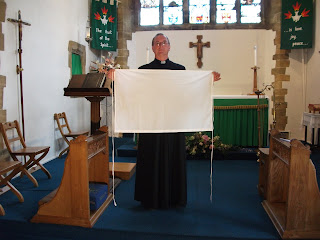PRIESTS CLOTHES FOR THE EUCHARIST / HOLY COMMUNION / THE LORD’S SUPPER
1. THE AMICE:

Symbolic of a mediaeval headpiece.
A hood or helmet.
White for purity and practical in so far as it can be changed and washed more easily than and alb!
Symbol of the Helmut of Salvation. (ref. Ephesians 6.10ff - put on the armour of God)
Sometime with embroidered strips called an ‘Apparel’ which forms a stiff standing collar

2. THE ALB:
a Roman tunic based on the dalmatica.

Usually white to symbolise purity.
Put on over the ordinary garments it symbolises putting on the purity of Christ over our sinful self so the person wearing it symbolises the work Christ did by forgiving our sins and making us clean and pure from sin.
Amice and alb.

Here is a picture showing the alb with the amice appearing as a collar

3. THE GIRDLE:

A belt, usually made of rope, which wraps around the waist.
Practical use: it helps to gather up the alb when it may be too long.
 Symbolises the girdle of faith which we are wrapped up in and which is used to tie in the symbol of working – the Stole.
Symbolises the girdle of faith which we are wrapped up in and which is used to tie in the symbol of working – the Stole.4. THE STOLE:
from the Roman ‘Orarium’ – originally a possible form of napkin, but in the reign of Emperor Aurelian he granted them as badges of distinction. By the 7c AD it was adopted into the church as a symbol of authority.
Symbolises the wearer is at work and that this work is tied up with their faith (the girdle).
5. THE MANIPLE: no longer used – it was also known as ‘fanon’ or ‘sudarium’.
Its origin was as a napkin used to wipe off moisture and perspiration from the face and eyes and was attached to the left wrist. Enjoined on deacons of the church from 253AD then adopted by priests. Became more ornamental and looked similar to a very short and small stole, often being made of the same material and colours as a matching stole, it dropped out of use Post Vatican 2, but was never very popular as it could often drop into or spill the chalice.
6. THE CHASUBLE:

A Roman outer garment which by the 6C AD replaced the toga as official wear by nobles and senators. As early as 253 AD it was used by priests when celebrating the mass.
(The word ‘vestimentum’ applies strictly, not to a set of mass vestments but to the chasuble only).
Often richly decorated. Worn over the alb, girdle and stole, it Symbolises that the faith at work should not be kept hidden inside but should be spread all over the outside world.
It is a symbol that our faith in Christ should be taken out into the world, and is a call to all Christians to be evangelistic in their lives. (see also page about 'symbolism of laying out the eucharistic robes')
Symbolises the wearer is at work and that this work is tied up with their faith (the girdle).
5. THE MANIPLE: no longer used – it was also known as ‘fanon’ or ‘sudarium’.
Its origin was as a napkin used to wipe off moisture and perspiration from the face and eyes and was attached to the left wrist. Enjoined on deacons of the church from 253AD then adopted by priests. Became more ornamental and looked similar to a very short and small stole, often being made of the same material and colours as a matching stole, it dropped out of use Post Vatican 2, but was never very popular as it could often drop into or spill the chalice.
6. THE CHASUBLE:

A Roman outer garment which by the 6C AD replaced the toga as official wear by nobles and senators. As early as 253 AD it was used by priests when celebrating the mass.
(The word ‘vestimentum’ applies strictly, not to a set of mass vestments but to the chasuble only).
Often richly decorated. Worn over the alb, girdle and stole, it Symbolises that the faith at work should not be kept hidden inside but should be spread all over the outside world.
It is a symbol that our faith in Christ should be taken out into the world, and is a call to all Christians to be evangelistic in their lives. (see also page about 'symbolism of laying out the eucharistic robes')


No comments:
Post a Comment